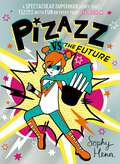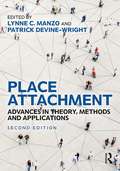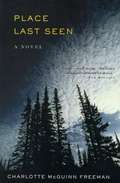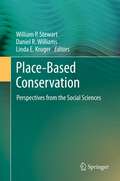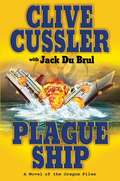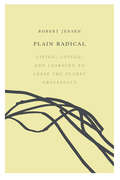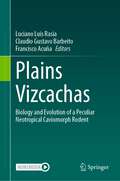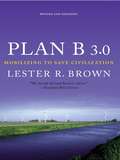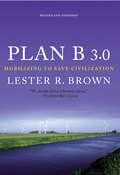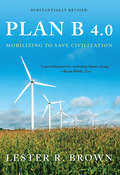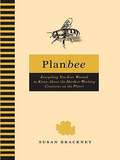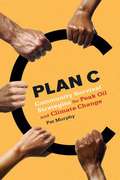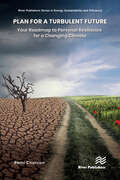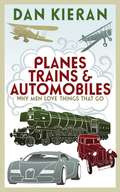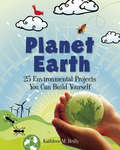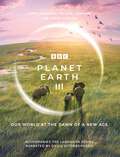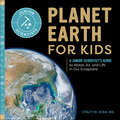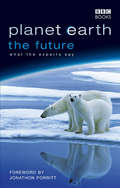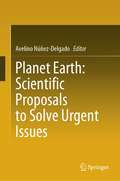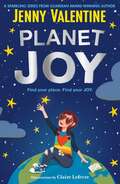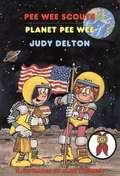- Table View
- List View
Pizazz vs The Future (Pizazz #6)
by Sophy HennThe sixth book in the SUPER graphic novel-like series for readers aged 7+ from the amazingly talented illustrator and author Sophy Henn! Brimming with Sophy's hilarious illustrations, this is the perfect read for fans of Bunny Vs Monkey, Tom Gates, Amelia Fang, Wimpy Kid and Dog Man. Everyone's favourite reluctant superhero is back and ready to give this super thing her ALL – she's even got a BRAND-NEW COSTUME. Pizazz soon discovers that a bunch of baddies have formed TEAM TOXIC and are trying to DESTROY the PLANET for ever, but none of the grown-ups even care! This time it&’s up to Pizazz and her friends to save the world . . . before it destroys ITSELF! Praise for Pizazz: &“A SPECTACULAR superhero story that fizzes with fun on every page!&” – Liz Pichon, author of the bestselling TOM GATES series. &“Blocky comic-style panels, a fire-farting granddad and a conservationist message make for accessible, quirky reading&” – The Guardian, Children&’s Book of the Month &“Sophy Henn&’s funny new series […] a witty and original reminder that superheroes are human too&” – The Sunday Times, Children&’s Book of the Week &“Sophy Henn&’s lively, energetic story should be a hit with anyone who finds it hard to fit in&” – Financial Times &“Full-page illustrations, comic-strip sequences, quirky typography and dramatic chapter openers ensure this book will appeal to more reluctant readers&” – The i &“Perfect for fans of her previous series Bad Nana, with the same level of illustration and zany text throughout&” – BooktrustHilariously narrated by reluctant superhero Pizazz, and brimming with Sophy Henn&’s distinctive illustrations and comic-book strips, this is the sixth book in the laugh-out-loud PIZAZZ series! Look out for more Pizazz adventures: Pizazz, Pizazz Vs The New Kid, Pizazz Vs Perfecto, Pizazz Vs The Demons and Pizazz Vs Everyone!
Place Attachment: Advances in Theory, Methods and Applications
by Patrick Devine-Wright Lynne C. ManzoFollowing on from the ground-breaking first edition, which received the 2014 EDRA Achievement Award, this fully updated text includes new chapters on current issues in the built environment, such as GIS and mapping, climate change, and qualitative approaches. Place attachments are powerful emotional bonds that form between people and their physical surroundings. They inform our sense of identity, create meaning in our lives, facilitate community, and influence action. Place attachments have bearing on such diverse issues as rootedness and belonging, placemaking and displacement, mobility and migration, intergroup conflict, civic engagement, social housing and urban redevelopment, natural resource management, and global climate change. In this multidisciplinary book, Manzo and Devine-Wright draw together the latest thinking by leading scholars from around the globe, including contributions from scholars such as Daniel Williams, Mindy Fullilove, Randy Hester, and David Seamon, to capture significant advancements in three main areas: theory, methods, and applications. Over the course of fifteen chapters, using a wide range of conceptual and applied methods, the authors critically review and challenge contemporary knowledge, identify significant advances, and point to areas for future research. This important volume offers the most current understandings about place attachment, a critical concept for the environmental social sciences and placemaking professions.
Place Last Seen
by Charlotte Mcguinn FreemanDURING AN IDYLLIC AUTUMN-DAY hike in the Desolation Wilderness of the Sierra Nevadas, the Baker family is hurled into a nightmare. Playing hide-and-seek with her older brother, Luke, six-year-old Maggie runs away-and she cannot be found. Her father, Richard, and mother, Anne, search desperately before racing down the mountain to call in a Search and Rescue team. The team arrives with experienced trackers, volunteers, dogs, and topographic maps and begins a thorough search from the place where Maggie was last seen. But the search is complicated by an unpredictable factor: willful and energetic, Maggie Baker is also a Down Syndrome child, and there is no telling how she will move as she wanders in the wilderness. Richard, Anne, and Luke can only wait and hope that she will leave a clue, a trail that will lead them to her. With great empathy, Charlotte McGuinn Freeman conveys the gripping reality of the search and how this tests the bonds of a family as it grapples with guilt, doubt, fear, and frantic hope. Powerful, suspenseful, and deeply affecting, Place Last Seen marks the debut of a gifted new voice.
Place of the Wild: A Wildlands Anthology
by John Davis David Abram Kirkpatrick Sale Max Oelschlaeger David Clarke Burks Margaret Hayes YoungWhere and what is the place of the wild? Is the goal of preserving biodiversity across the landscape of North America compatible with contemporary Western culture?Place of the Wild brings together original essays from an exceptional array of contemporary writers and activists to present in a single volume the most current thinking on the relationship between humans and wilderness. A common thread running through the volume is the conviction that everyone concerned with the natural world -- academics and activists, philosophers and poets -- must join forces to re-establish cultural narratives and shared visions that sustain life on this planet.The contributors apply the insights of conservation biology to the importance of wilderness in the 21st century, raising questions and stimulating thought. The volume begins with a series of personal narratives that present portraits of wildlands and humans. Following those narratives are more-analytical discourses that examine conceptions and perceptions of the wild, and of the place of humanity in it. The concluding section features clear and resonant activist voices that consider the importance of wildlands, and what can be done to reconcile the needs of wilderness with the needs of human culture.
Place-Based Conservation
by Linda E. Kruger Suzette Dailey William P. StewartThe concept of "Place" has become prominent in natural resource management, as professionals increasingly recognize the importance of scale, place-specific meanings, local knowledge, and social-ecological dynamics. Place-Based Conservation: Perspectives from the Social Sciences offers a thorough examination of the topic, dividing its exploration into four broad areas. Place-Based Conservation provides a comprehensive resource for researchers and practitioners to help build the conceptual grounding necessary to understand and to effectively practice place-based conservation.
Places in My Community (Into Reading, Read Aloud #Module 3, Book 1)
by Bobbie KalmanNIMAC-sourced textbook
Placing Nature: Culture And Landscape Ecology
by Joan Nassauer Chris FaustLandscape ecology is a widely influential approach to looking at ecological function at the scale of landscapes, and accepting that human beings powerfully affect landscape pattern and function. It goes beyond investigation of pristine environments to consider ecological questions that are raised by patterns of farming, forestry, towns, and cities.Placing Nature is a groundbreaking volume in the field of landscape ecology, the result of collaborative work among experts in ecology, philosophy, art, literature, geography, landscape architecture, and history. Contributors asked each other: What is our appropriate role in nature? How are assumptions of Western culture and ingrained traditions placed in a new context of ecological knowledge? In this book, they consider the goals and strategies needed to bring human-dominated landscapes into intentional relationships with nature, articulating widely varied approaches to the task.In the essays: novelist Jane Smiley, ecologist Eville Gorham, and historian Curt Meine each examine the urgent realities of fitting together ecological function and culture philosopher Marcia Eaton and landscape architect Joan Nassauer each suggest ways to use the culture of nature to bring ecological health into settled landscapes urban geographer Judith Martin and urban historian Sam Bass Warner, geographer and landscape architect Deborah Karasov, and ecologist William Romme each explore the dynamics of land development decisions for their landscape ecological effects artist Chris Faust's photographs juxtapose the crass and mundane details of land use with the poetic power of ecological pattern.Every possible future landscape is the embodiment of some human choice. Placing Nature provides important insight for those who make such choices -- ecologists, ecosystem managers, watershed managers, conservation biologists, land developers, designers, planners -- and for all who wish to promote the ecological health of their communities.
Plague Ship: A Novel of the Oregon Files #5
by Clive Cussler Jack DubrulAn exhilarating new adventure in the New York Times-bestselling Oregon Files series. "Readers will burn up the pages following the blazing action and daring exploits of these men and women and their amazing machines" (Publishers Weekly). For four novels, Clive Cussler has charted the exploits of the Oregon, a covert ship completely dilapidated on the outside but on the inside packed with sophisticated weaponry and intelligence-gathering equipment. Captained by the rakish, one-legged Juan Cabrillo and manned by a crew of former military and spy personnel, it is a private enterprise, available for any government agency that can afford it-and now Cussler sends the Oregon on its most extraordinary mission yet. The crew has just completed a top secret mission against Iran in the Persian Gulf when they come across a cruise ship adrift at sea. Hundreds of bodies litter its deck, and, as Cabrillo tries to determine what happened, explosions rack the length of the ship. Barely able to escape with his own life and that of the liner's sole survivor, Cabrillo finds himself plunged into a mystery as intricate-and as perilous-as any he has ever known and pitted against a cult with monstrously lethal plans for the human race... plans he may already be too late to stop. Plague Ship is a high-stakes, high-seas journey that proves once again that Cussler is "just about the best storyteller in the business" (New York Post).
Plain Radical: Living, Loving and Learning to Leave the Planet Gracefully
by Robert JensenThere was nothing out of the ordinary about Jim Koplin. He was just your typical central Minnesota gay farm boy with a Ph.D. in experimental psychology who developed anarchist-influenced, radical-feminist, and anti-imperialist politics, while never losing touch with his rural roots. But perhaps the most important thing about Jim is that throughout his life, almost literally to his dying breath, he spent some part of every day on the most important work we have: tending the garden.Plain Radical is a touching homage to a close friend and mentor taken too soon. But it is also an exploration of the ways in which an intensely local focus paired with a fierce intelligence can provide a deep, meaningful, even radical engagement with the world.Drawing on first hand accounts as well as the nearly 3,000 pages of correspondence that flowed between the two men between 1988 and 2012, this book is about the intersection of two biographies and the ideas two men constructed together. It is in part a love story, part intellectual memoir, and part political polemic; an argument for how we should understand problems and think about solutions-in those cases when solutions are possible-to create a decent human future.
Plains Vizcachas: Biology and Evolution of a Peculiar Neotropical Caviomorph Rodent
by Luciano Luis Rasia Claudio Gustavo Barbeito Francisco AcuñaThe plains vizcacha (Lagostomus maximus) is a remarkable rodent of the Neotropic given several peculiar aspects of its biology, some of them quite unique among rodents or even among mammals. This book gathers specialists studying plains vizcachas from very different approaches, including paleontology, systematics, morphology, physiology, development and conservation. It is divided in two Parts, 1) Evolutionary History, and 2) Morphology, Development and Physiology. It will surely be a required reading for any researcher working with caviomorph rodents, mastozoology of the Neotropics or internal anatomy and physiology of mammals.
Plan B 3. 0: Mobilizing to Save Civilization
by Lester R. BrownThe world faces many environmental trends of disruption. This book has a survival strategy for the early twenty-first-century civilization.
Plan B 3.0: Mobilizing to Save Civilization (Substantially Revised)
by Lester R. Brown"How to build a more just world and save the planet....We should all heed Brown's advice."--Bill Clinton In this updated edition of the landmark Plan B, Lester Brown outlines a survival strategy for our early twenty-first-century civilization. The world faces many environmental trends of disruption and decline, including rising temperatures and spreading water shortage. In addition to these looming threats, we face the peaking of oil, annual population growth of 70 million, a widening global economic divide, and a growing list of failing states. The scale and complexity of issues facing our fast-forward world have no precedent With Plan A, business as usual, we have neglected these issues overly long. In Plan B 3.0, Lester R. Brown warns that the only effective response now is a World War II-type mobilization like that in the United States after the attack on Pearl Harbor.
Plan B 4.0: Mobilizing to Save Civilization (Substantially Revised)
by Lester R. Brown"[Brown's] ability to make a complicated subject accessible to the general reader is remarkable."--Katherine Salant, Washington Post As fossil fuel prices rise, oil insecurity deepens, and concerns about climate change cast a shadow over the future of coal, a new energy economy is emerging. Wind, solar, and geothermal energy are replacing oil, coal, and natural gas, at a pace and on a scale we could not have imagined even a year ago. For the first time since the Industrial Revolution, we have begun investing in energy sources that can last forever. Plan B 4.0 explores both the nature of this transition to a new energy economy and how it will affect our daily lives.
Plan Bee
by Susan BrackneyA guided tour inside the world of beesOvertaxed and underrecognized-and now disappearing in alarming numbers- bees are the unsung heroes of the food chain, essential for the pollination of more than ninety of the crops we eat. The hardworking, humble, and matriarchal bee finally gets her due in this engaging and expertly written guide that will appeal to anyone who's ever been curious about the mysterious and always-buzzing world of bees. Beekeeper Susan Brackney explains:* Why honeybees are disappearing-and what we can do about it* Who's who in the hive-the queen bee, the workers, and the drones* Bees by the numbers-the number of bees per hive, the number of wing beats per second, and other fascinating facts* Gardening tips to attract and support honeybees* The beekeeper's trade-the essential equipment and the latest tools, a day in the life, and more* Honey, pollen, wax, royal jelly, mead, and other products of the sweet life* The secrets behind making a bee beard (or bee bikini) with live bees. . . and much more
Plan C: Community Survival Strategies for Peak Oil and Climate Change
by Pat MurphyA sustainability expert goes beyond renewables, calling on us to combat the climate crisis with a new, low-energy way of life.Concerns over climate change and energy depletion are increasing exponentially. Mainstream solutions still assume that some miracle will cure our climate ills without requiring us to change our energy-intensive lifestyle. But switching from fossil fuels to renewable energy sources isn’t enough. We need a Plan C.In response to the converging crises of Peak Oil, climate change, and increasing inequity, sustainability expert Pat Murphy offers an inspiring vision of community and curtailment. Where cooperation replaces competition, we can deliberately reduce consumption of consumer goods. Plan C shows how each person's individual choices can dramatically reduce CO2 emissions, offering specific strategies in the areas of food, transportation, and housing.
Plan for a Turbulent Future: Your Roadmap to Personal Resilience for a Changing Climate
by Remi CharronMillions of lives and businesses have either been lost or significantly impacted by COVID-19. Yet, many are warning that climate change will be much more devastating over the coming decades. Reality is starting to set in. We are not going to achieve our global mitigation targets; we probably won’t even come close. Individuals faced with this reality react differently, from willful ignorance to anxiety and depression, all normal reactions. If you believe in science and understand the likelihood of our failure to meet our targets, you need to accept and plan for an unknown, challenging future. We may be individually powerless to stop climate change, but we certainly can act in ways that will help us better face the consequences. This book provides a structured approach to plan and prepare today for a world rocked by a turbulent climate.
Planes, Trains and Automobiles: Why Men Like Things that Go
by Dan KieranWhat is it about an engine roaring into life that makes grown men go weak at the knees? This is a book about machines and the men who love them. Some of these men are quite odd. Having always been a mechanaphobe himself, living in the slow lane, Dan Kieran is on a mission to discover the allure of machines and man's need for speed. Follow Dan as he climbs aboard a penny-farthing for a jaunt around west London, drives a steam train through the 'alps', joins the pit lane crew of Mitsubishi for the Britcar 24-hour race at Silverstone, discovers the link between Lawrence of Arabia and the 'wall of death', meets tank (yes, tank) collectors and the men behind 'digger ballet', learns to fly in the shadow of Douglas Bader and, along the way, wrestles with Aristotle, Jeremy Clarkson, Plato, Hunter S. Thompson and, mostly, himself.Join Dan as he makes a journey of discovery into another world, the happy and quirky world of the Great British potterer and machine enthusiast. Could he even be tempted to stay there?
Planet Earth
by Farah Rizvi Kathleen M. ReillyPlanet Earth: 25 Environmental Projects You Can Build Yourself provides an engaging guide to the natural world and encourages children ages 9 and up to get their hands dirty and actively connect with the environment. It then introduces key environmental issues-wind and solar power, pollution, endangered species, global warming, and recycling-and posits potential solutions. Trivia, fun facts, and 25 captivating hands-on projects investigate ecology basics, such as the food chain, oxygen, and animal habitats, as well as ways to lessen the strain on Earth's resources by reducing human consumption and waste. With Planet Earth kids will learn how to respect and protect our unique planet.
Planet Earth III: Accompanies the Landmark Series Narrated by David Attenborough
by Jonny Keeling Matt Brandon Michael GuntonThe official tie-in to the third instalment in the legendary Planet Earth franchiseFew places on Earth remain untouched by humans, creating challenges for the wildlife we share it with. We have entered a new age, and we must look at the splendour of the natural world through a different lens.From the depths of our oceans, to scorching deserts and the most remote jungles, Planet Earth III features spectacular places and surprising animal behaviours from all corners of our world. And for the first time, a human element is introduced to each landscape, highlighting how, in the age of the Anthropocene, today's planet has been forever changed by humanity and that wildlife now faces new challenges in our crowded, modern world.Featuring over 250 beautiful full-colour photographs, Planet Earth III reveals the wonders and trials of life on an increasingly fragile planet, bringing you closer than ever before to our world’s most intriguing species, unseen landscapes and natural phenomena.
Planet Earth for Kids: A Junior Scientist's Guide to Water, Air, and Life in Our Ecosphere (Junior Scientists)
by Stacy W KishExplore the land, water, and sky with the Junior Scientists series for kids ages 6 to 9 Have you ever wondered what makes the weather change? Or how mountains, rivers, and valleys get their shapes? Answer these questions and more with Planet Earth for Kids! You'll explore how our planet became the perfect home for all its plants and animals and how our air, sun, water, and dirt make planet Earth unique.Photos and illustrations—Beautiful pictures and fascinating diagrams let you take a peek at everything from penguins and storm clouds to the different types of rocks.Facts and activities—Discover what causes volcanoes, how much salt is really in the ocean, and even how to build your own solar-powered pizza oven!Earth ecosystems—Learn about the different biomes and habitats all over planet Earth and the plants and animals that work together to keep them healthy.Find out what keeps all life on Earth in balance with Planet Earth for Kids.
Planet Earth, The Future
by Fergus Beeley Jonathan Porritt Rosamund Kidman CoxPlanet Earth is the most spectacular look at our planet that has ever been broadcast. It has made millions of viewers aware of the breathtaking beauty and variety of life on our planet, and just as importantly how fragile that life can be. The premise of Planet Earth - The Future is to identify environmental and conservation issues that surround some of the sequences in Planet Earth, and put these issues to leading commentators, including NGO's, politicians and religious leaders James Leape (WWF International), Jeffrey McNeely (World Conservation Union), and the Archbishop of Canterbury to name but a few of the 35 contributors. We are living in destructive times, and our responsibility for the planet's stewardship is something none of us can afford to ignore. Comprised of transcripts from the series interviews, thoughtfully edited and abbreviated, this compelling and insightful book serves as a timely reminder of what needs to be done and what can be done to keep Planet Earth alive.
Planet Earth: Scientific Proposals to Solve Urgent Issues
by Avelino Núñez-DelgadoThis book represents the most comprehensive overview of issues affecting our planet and the forefront solutions, including climate change, air, water, soil pollution, demography, and access to food and water. This edited book, led by Prof. Núñez-Delgado, counts with the participation of leading researchers across a wide range of disciplines to be an inspiring and motivating document to promote sustainability and biodiversity. Those of you asking for trustworthy analyses about sustainability and climate change and the vanguard solutions will find this book fascinating.
Planet Joy
by Jenny ValentineFor readers aged 9+ comes the third book in a sparkling series about family, friends and finding the joy in life! From Guardian award-winning author Jenny Valentine, this is the perfect series for fans of Jacqueline Wilson, Cath Howe and Lara Williamson! Meet ten-year-old Joy Applebloom, a girl with a knack for finding the silver lining in even the darkest of rainclouds. After years of travelling the world with her family, Joy feels like she&’s finally found a place she can call home. She&’s settled in at school, has a new best friend called Benny and she&’s finally making a difference in the world. But when a new girl, Phoebe Dark, joins class 6C, Joy discovers there&’s a whole world out there that she hasn&’t explored yet . . . Could Plane Tree Gardens be just the beginning?A heart-warming and joyful series about family, friends and never being too small to make a difference, with gorgeous illustrations from Claire Lefevre. 'A delight for its warmth and humour, but principally because the writing is alive and stunning' The Sunday Times on A Girl Called Joy
Planet Ocean
by Paul Watson Jan DutkiewiczVeteran environmental activist and Whale Wars host Paul Watson offers in this interview a provocative and revolutionary view of the state of an environment in crisis. The planet may survive our environmental destruction, he argues, but humans may not. Focused on protecting oceans, preventing the loss of biodiversity, and promoting individual action, Watson's singular call to arms challenges the typical talking points of the modern environmental movement.
Planet Pee Wee (Pee Wee Scouts #34)
by Judy DeltonEveryone in the Pee Wee Scouts wants to win a trip to Camp Blast Off, the super-cool summer camp where kids learn what it's like to be an astronaut. But there's only room for one scout from each troop in the country. So the Pee Wee Scouts set out to make the best project about the planets and the solar system: Roger is building model meteors and stars with light bulbs, Rachel is stirring up a recipe for freeze-dried peanut butter. Find out what Molly and Mary Beth are working on--maybe the most exciting project of all! The Pee Wees goof around, do good deeds, take on projects and have fun and adventures. Find out all about what scouts do in the other 38 Pee Wee Scout books you can get from Bookshare including: #1 Cookies and Crutches, #2 Camp Ghost-Away, #3 Lucky Dog Days, #4 Blue Skies, French Fries, #5 Grumpy Pumpkins, #6 Peanut-Butter Pilgrims, #7 A Pee Wee Christmas, #8 That Mushy Stuff, #9 Spring Sprouts, #10 The Pooped Troop, # 11 The Pee Wee Jubilee, #12 Bad, Bad, Bunnies, #13 Rosy Noses, Frozen Toes, #14 Sonny's Secret, #15 Sky Babies, #16 Trash Bash, # 17 Pee Wees On Parade, #18 Lights, Action, Land-ho!, # 19 Piles of Pets, #20 Fishy Wishes, #21 Pee Wees On skis, #22 Greedy Groundhogs, #23 All Dads on Deck, #24 Tricks and Treats, #25 Pee Wees on First, # 26 Super Duper Pee Wees, #27 Teeny Weeny Zucchinis, #28 Eggs With Legs, #29 Pee Wee Pool Party, #30 Bookworm Buddies, #31 Moans and Groans and Dinosaur Bones, #32 Stage Frightened, #33 Halloween Helpers, #35 Pedal Power, #36 Computer Clues # 37 Wild, Wild West, #38 Here Come the Clowns, and #39 Molly For Mayor.
